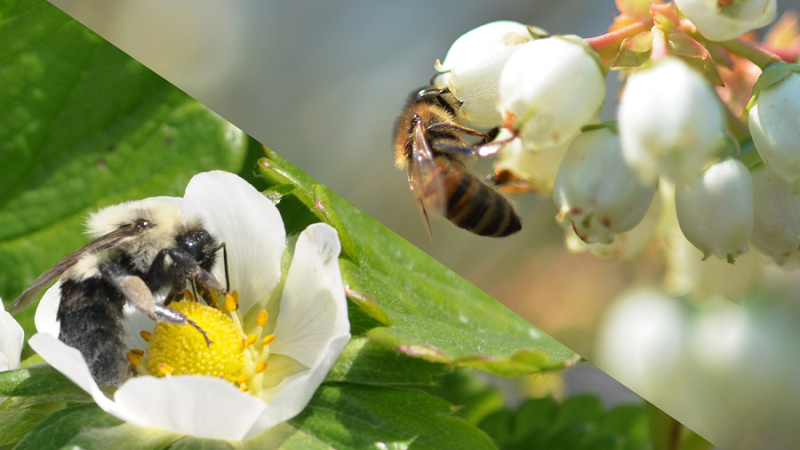Scientists Aim to Improve Nitrogen, Water Use Efficiency in Lettuce

Sprinkler irrigation is used on a baby lettuce field in California’s Imperial Valley. Photo credit: David Still
As the West continues to deal with the negative effects of a drought, growers are tasked with finding creative approaches to save water. Making the switch to drip irrigation, using improved irrigation software, and crop diversification are just a few of the methods being used to scale back water use.
In the spirit of innovation, David Still, Professor at Cal Poly, and his team of researchers are studying ways to grow lettuce with less water and nitrogen after receiving a research grant from the California Leafy Greens Marketing Board and the California Department of Food and Agriculture.
By identifying different DNA markers in the plants associated with nitrogen uptake and water usage, Still and his researchers aim to produce lettuce varieties that could potentially save up to 15% on nitrogen.
A New Approach
The impetus for funding this particular project was the severity of the ongoing drought, Still explains.
“The California Leafy Greens Research Board identified water as one of the major problems growers are facing. The state has been through several years of drought and none of the climate models anticipate that we will be receiving much more water,” Still says.
Current research says the state of California will be receiving at least 15% less rainfall moving forward, and even less in the Southwest.
Regarding nitrogen, because California is now measuring the nitrates in the groundwater, growers are being asked to limit the amount of nitrogen applied to their crops. Nitrogen volatilization, or the process by which nitrogen is released into the atmosphere producing a potent greenhouse gas, has provided further need for the reduction of nitrogen-based fertilizers, according to Still.
Depending on the production area, Still says — on average — growers are applying up to 250 pounds of nitrogen per acre.
“We know that in California there are more than 130,000 acres and we have produced varieties that can save up to 14% on nitrogen, which gets to be a lot,” he says.
Entering Uncharted Territory
Being the first of its kind, Still’s research has not been without its set of unique challenges.
“Before this project, nobody has ever talked about breeding for improved water use or nitrogen use efficiency because they didn’t need to,” he explains.
“Nitrogen use is incredibly unstable from field to field, and year to year. As a breeder in a seed company, you can’t say, ‘Hey, I have this variety that’s guaranteed to produce 10% more vitamin A, year after year, no matter what the circumstance.’ It’s a very complex trait, and part of figuring this out is about stabilizing the expression of that trait.”
Using Controlled Studies
The first half of Still’s research, which was funded by a separate grant, focused on planting a number of genotypes in various fields and monitoring the amount of nitrogen in the leaves, which indicates uptake from the soil. They monitored water uptake as well and selected the best varieties based on the combined data.
“One of the things we noticed through the work in our fields is that if you were to grow the same variety and harvest it on the same day but in different parts of your growing region — or even in different fields a half a mile away — there would be so much variability between some varieties that it was astounding,” Still says.
“We thought the environmental conditions were interfering with the genetic potential, so we got more funding and started to do controlled studies in the lab.”
The plants are grown in controlled conditions in the lab where nitrogen levels and soil temperatures are all identical. The team of researchers then measured the data of the same varieties and genotypes used in the field and developed a new ranking.
“What that gave us is the genetic potential of the plant. We’ve now identified the best varieties and genotypes from our field, and we’ve identified the best genotypes from our lab, and now we’re going to create new genetic lines based on these two independent studies,” Still says.
The team is now in the process of creating these new genetic lines, which they will take back to the field and screen for the best performing varieties.
An Unlikely Cross
Still’s team of researchers also is looking at wild germplasm as a way to introduce desirable traits into the varieties, and has worked on crossing lettuce with certain weeds to achieve this.
“There are a lot of valuable genetics out there. However, if you cross a weed with some of the varieties that you get from the grocery store, most of those crosses end up looking like weeds,” Still says.
“What we have to do is develop those DNA markers, cross it again with the commercial cultivars, and make another selection based on the DNA markers.”
If this process is repeated two or three times, the researchers can recover the rest of the genome that makes the plant look more like the commercial cultivar.
The flavor and nutritional profile also are affected by this process, so those markers are being observed in addition to the appearance.
Working Alongside Seed Breeders
Still says that the team is working with 40 or 50 lettuce varieties from a number major seed breeders.
“Some varieties are from the desert and some of them are from the coastal areas. We have what I think is a good representation,” Still says.
He explains the intention of the research is not to bring “polished” varieties to market, but instead to present seed breeders with the DNA markers so they can make crosses with their own material to include disease resistance and any other desired traits.
As of right now, the early generations of the germplasm will be available to seed breeders in the summer or fall of 2018 by the time the current grant ends.









